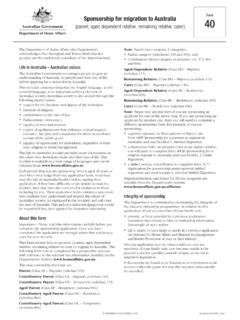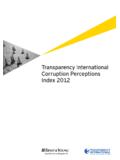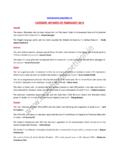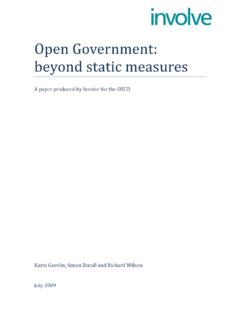Transcription of OECD COMPARATIVE STUDY
1 OECD COMPARATIVE STUDY REBOOTING PUBLIC SERVICE DELIVERY: HOW CAN OPEN GOVERNMENT DATA HELP TO DRIVE INNOVATION?TABLE OF CONTENTS Introduction: Open Data and the new frontier of innovative service delivery .. 2 What innovation can Open Data foster? .. 3 Innovating ordinary citizens experience .. 3 Building the next generation of empowered civil servants .. 6 Innovating public procurement .. 6 Evolving public sector internal dynamics .. 7 Predictive Data Analytics helps spotting emerging governmental and societal needs .. 8 Promoting collective learning, collective intelligence and social participation in service delivery and policy making .. 9 Maximising value and capturing impact on innovation .. 10 Scaling it up to make it sustainable .. 10 Improving impact and measuring capabilities.
2 12 Unleashing the potential of Open Data in the UAE .. 13 The policy context for OGD implementation in the UAE .. 13 Overcoming the main challenges to maximise OGD impact .. 13 Raising public awareness and consulting data users .. 15 Stimulating engagement and participation to spur innovation .. 17 Linking open government data with evidence-based policy making .. 19 Maximising OGD impact through social media .. 21 22 REFERENCES .. 24 Tables Table 1. Most popular government leaders on Twitter when accounting for population sizes, 2013 22 Figures Figure 1. The OECD OURData Index .. 3 Figure 2. Top 5 principal objectives of the Open Data strategy/policy .. 11 Figure 3. Principal challenges to further development of OGD initiatives .. 14 Figure 4. Elements part of the central government OGD strategy/policy.
3 15 Figure 5. Was central/federal OGD strategy/policy developed in consultation with stakeholders? 16 Figure 6. Does your government regularly consult users on their needs and preferences for the type of data released? .. 17 Figure 7. Facebook penetration in MENA and GCC countries .. 21 Boxes Box 1. Datapalooza: Innovating health services in the US .. 5 Box 2. San Francisco improves service delivery to disadvantaged youngsters .. 10 Box 3. The PISA data "shock" in Germany as a trigger of education reforms .. 19 Box. 4 Leveraging open data to better manage gender related issues .. 20 2 Introduction: Open Data and the new frontier of innovative service delivery Open Government Data (OGD) policies, programmes and initiatives have the potential to provide a number of benefits from public governance and socio-economic perspectives (OECD, 2013).
4 Largely praised and supported by advocates of government transparency, Open Data offers also means for developing new solutions built on top of government data released in machine-readable formats that can be leveraged to innovate public sector processes and public service delivery. These data are normally referred to as liquid data which means open, widely available, and in shareable formats. Open Data has the potential to trigger a revolutionary approach on how governments think about providing services to citizens and how they measure efficiency in the service delivery as well as users satisfaction. A great amount of innovation is happening across OECD and non-OECD countries as a result of the higher availability of open government data.
5 A primary driver of this trend appears being the fact governments increasingly uptake the idea of open innovation. This implies unleashing the power of non-institutional stakeholders such as the private sector, the academic sector, the non-profit sector, as well as the public in general, to accomplish more than what the government could do alone. Opening up government data provides indeed the opportunity to involve innovators from inside and outside governments to create innovative ways to tackle old and new problems. This has the potential to increase government efficiency and effectiveness, as well as to innovate the delivery of services and the internal public sector operations. Additionally, the use of new technology and data analytics within the public sector, and the integration of analysis in policy making and in the design of public services, can boost more integrated and innovative service delivery.
6 This potential bodes well with a general trend happening across OECD and non-OECD member countries articulated by Tim O Reilly s concept of government as a platform (O Reilly, 2010). Governments role is changing, as governments are no longer expected to be the sole provider of responses and solutions to wicked problems that increasingly require joined-up answers. This implies the government s capacity to act as a facilitator, providing the platform for institutional and non-institutional actors to collaborate to jointly produce common solutions. Open government data is at the heart of this change that is taking place in governments. Since the inception of the internet, and its increasingly central role in how governments deliver services and information to citizens and businesses, governments have used data as an input into a finished product , a service delivered to users (O Reilly, 2013).
7 Government Data made available as open/liquid data are now provided to non-institutional actors who can use them to develop innovative and valuable new solutions, this directly contributing to public sector innovation. This is a new form of open and collective public sector innovation. Hence, the data become the platform to be used to encourage the development of new useful applications and solutions. However, data accessibility and availability are necessary but insufficient conditions to deliver the expected value from socio, economic and good governance perspectives ( transparency, integrity, accountability). The re-use of data by the public sector, by civil society organisations, by the private sector and by a host of other actors is a sine qua non condition to deliver the benefits of open data.
8 Yet, taking advantage of this opportunity has several implications. It entails first and foremost a significant change in the way governments operate and conceive their role as service providers ( rethinking government s role), which might be a long and complex process, fraught with risks: instead of being the provider of the final solution the government becomes the data steward (Helbig, Cresswell, Burke, Luna-Reyes, 2012). This implies also exploring new forms of partnerships with non-institutional actors in the creation of data and in the re-use of it to deliver for instance new services and solutions to citizens and businesses. Moreover, governments need to refine their capacity 3 to understand citizens specific needs, behaviours and mental models, and to use the data to respond to these needs.
9 The OECD OURdata Index aims to help strengthening governments' focus on impact and to remember that the overall objective should not be on increasing data availability, but on actively fostering stakeholders' engagement in data reuse. The OURdata Index is based on the OECD methodology for measuring Open Government Data (Ubaldi, 2013) and on the G8 Open Data Charter, encapsulating the first set of internationally agreed-upon set of principles on Open Data. This is essential, as the OURdata Index is also intended to help governments monitor their progress in implementing their international OGD commitments. Ultimately, the OURdata Index aims to support governments in designing and implementing OGD strategies that deliver value to the public.
10 Figure 1. The OECD OURData Index Setting the conditions to deliver value Data for the Czech Republic, Hungary, Iceland, Israel and Luxembourg are not available. Data for Indonesia are for 2015. Source: 2014 OECD Survey on Open Government Data; OECD Government at a Glance 2015 This COMPARATIVE STUDY aims to highlight new opportunities emerging for public sector innovation while raising awareness on some of the main implications that need to be tackled to successfully grasp these potential benefits. The STUDY presents how some of the OECD countries have started dealing with these issues and how this can be of inspiration for the UAE to further advance the existing use of Open Data to foster innovative service delivery. What innovation can Open Data foster?
















